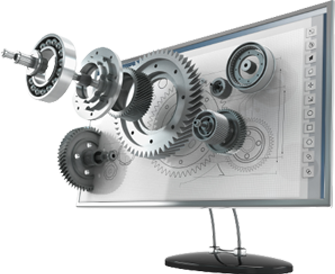Nondestructive Evaluation, Diagnosis, and Prognosis Division
Nondestructive Evaluation, Diagnosis, & Prognosis Division (NDPD) covers the evaluation of critical system components for material/defect/structure characterization through nondestructive methods, such as ultrasonics, radiography and other techniques

Events
Featured Event
QNDE 2024: 51st Annual Review of Progress in Quantitative Nondestructive EvaluationThe Inverness Denver - A Hilton Golf & Spa Resort
Denver, CO
July 22–24, 2024
Past Event
IMECE® International Mechanical Engineering Congress & Exposition®
October 29 – November 2, 2023, New Orleans, LA, USA
Congress-Wide Symposium on NDE & SHM
-
Special Panel on Frontiers of Manufacturing: In-Process Nondestructive Evaluation
-
NDPD Events at IMECE 2023
July 24–27, 2023, Austin, TX
QNDE - 49th Annual Review of Progress in Quantitative Nondestructive Evaluation
San Diego, CA
July 25 – 27, 2022
QNDE 48th Annual Review of Progress in Quantitative Nondestructive Evaluation
Online, Virtual
July 28 – 30, 2021
Honors & Awards
Recognition of outstanding achievement in engineering is one of the major objectives of ASME. Through its programs of honors and awards, ASME recognizes outstanding contributions to the art and science of engineering.
Division Awards
Leadership
Yuris Dzenis
Chair | July 2023 – June 2024
Andrei Zagrai
Vice Chair | July 2023 – June 2024
Sourav Banerjee
Treasurer | July 2023 – June 2024
Vivek Agarwal
Secretary | July 2023 – June 2024
Henrique Reis
Awards Chair | July 2023 - June 2024
Bikram Kundu
Member | July 2023 - June 2024
Portia Banerjee
Member | July 2023 - June 2024
Jeong-Beom Ihn
Member | July 2023 - June 2024
Jiaze He
Member | July 2023 - June 2024
Yan-Feng Shen
Member | July 2023 - June 2024
Victor Giurgiutiu
Member | July 2023 - June 2024
Barbara Zlatnik
Staff Contact
About
The NDE Division has traditionally focused on the evaluation of critical system components for material/defect/structure characterization through nondestructive methods, such as ultrasonics, radiography and other techniques. The role and scope of the nondestructive testing and evaluation is transforming rapidly. What we do, and how it is done, is changing due to expansion of the disciplinary boundaries, and rapid technological innovation. In this rapidly changing engineering environment, the NDE division shall provide technologically sound information that clearly defines risk versus reward and benefits versus consequences of new NDE technologies. Because of the accelerating rate of change in the development of new scientific discoveries and technological breakthroughs, the classical practices of NDE are not adequate to prepare globally competent NDE engineers and engineering leaders. NDE engineers need to stay current with technological advances and increasingly complex systems. The complexity of advanced technologies and the multiple scales (dimensions of size and time) at which systems now interact require designers, system integrators, operators and maintainers to collaborate in developing “cradle-to-grave” evaluation solutions.
NDE Engineers customarily design and specify inspection systems, make decisions regarding material condition, degradation acceptance, and remaining operating life of structures, systems and components. Additionally, design decisions made by engineers and operating environment and conditions significantly impacts inspection and NDE's role in management of plant aging. The NDE Engineering Division in its activities seeks to emphasize these integrated aspects of nondestructive evaluation and emerging system health monitoring, condition based maintenance and functional adaptation of system to its condition related technologies. The potential applications of structural health monitoring systems and benefits of this emerging technology are well documented. It is known that for complex structural and material systems, the ability to diagnose and predict structural failures through embedded sensing, actuation and data management can reduce operating costs while increasing safety. The key commercialization drivers for the technology are life cycle cost, avoidance of catastrophic failure and inspection of hard to reach places.
This division is pursuing creation of an international forum to address the current state-of-the-art technologies in NDE/NDT for mechanical systems. New and innovative approaches to the NDE/NDT and health monitoring of advanced materials, mechanical systems, and manufacturing systems are included as well as strategies for NDE/NDT data utilization for overall system safety, reliability, and performance. The division focuses on identifying and fostering improvements and new developments of technology in areas related to innovative inspection technologies, real-time monitoring, and cost-effective embedded or external sensory systems. It seeks to provide a medium for communication among engineers and scientists from stakeholder communities that include experts in NDE/NDT, SHM, sensors and sensor networks, system life management, energy harvesting, etc.
Vision
The NDE division aims to be the essential resource for mechanical engineers and other technical professionals throughout the world for disseminating technical knowledge associated with diagnosis and prognosis of mechanical systems as well as functional system adaptation to partially damaged state of the mechanical system. The division will interface with other divisions and groups within ASME and other professional engineering societies to enhance public safety and the quality of life.
Mission
The NDE division’s mission is to serve global engineering communities by advancing, disseminating and applying NDE/NDT knowledge for overall mechanical system safety, reliability improvement; and communicating the excitement of emerging technologies in the NDE discipline.
Links
Links to helpful online resources related to the division are below. If you have suggestions for other resources, please contact the division chair or ASME staff.
- American Society for Non Destructive Testing
- International Gas Turbine Institute
- Nuclear Engineering Division
- Petroleum Division
- Pressure Vessels and Piping Division
- Power Division
ASME Landmarks Program
Landmarks, sites and collections of historic importance to mechanical engineering are designated by ASME through its History and Heritage Landmarks Program.